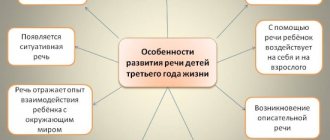Most often, speech disorders are detected at the age of 3 years, when the child begins to actively speak. Using a real example, we tell you what general speech underdevelopment (GSD) is in children, whether it is a dangerous diagnosis or not, and how you can help your child speak at home.
⠀
Speech development disorders can occur in children raised in ordinary families, and in children from bilingual families, i.e. in congenital bilinguals, when the child’s parents speak different languages.
⠀
Young bilingual children learn two languages from early childhood - the first, the main language, and the second, which is spoken less often. Therefore, speech problems in such children are most often associated with incorrect pronunciation of sounds and mixing of languages in speech.
⠀
From this article you will learn:
- what is general speech underdevelopment (GSD) in children;
- Is this diagnosis dangerous or not?
- in what cases should you sound the alarm;
- what specialists to contact;
- How can you help your child speak at home?
⠀
To make it clearer for you, we will analyze all the questions using a real example.
What is general speech underdevelopment (GSD) in children?
General speech underdevelopment (GSD) is a violation of the development of speech skills in a child. Most often, it can be detected at the age of three, when the child begins to actively talk. But OHP is not a symptom of a serious illness, but most often simply insufficient attention of parents to the child’s speech. For example, if a child says “yba”, “suba”, “dau”, and the parents do not correct him, thinking that “it will go away on its own”.
⠀
Four months ago, one of the social networks of the Kidskey online school received the following message:
⠀
“My son is 4 years old. He has been going to kindergarten since he was 3 years old, but he hardly speaks. His speech is similar to the babble of a one-year-old child. I understand it only when it is explained by gestures. My friends reassure me that boys start talking later, but I am very worried because in the kindergarten the children do not want to play with my son, he constantly cries, gets angry and even offends his classmates.
⠀
I do not know what to do. Please tell me, should I do something now or should I wait until the child outgrows it? Is it necessary to go to a specialist or can you practice speech development at home?”
⠀
It is difficult to give some abstract advice without talking to the child. That's why we invited the mother and boy for a free online consultation.
⠀
Wonderful and smiling Roma had no problems with hearing or intelligence, but he communicated with our methodologist like this:
⠀
- instead of “give” he said “yes-yes”, instead of “there is” he said “us-us”;
- instead of a whole word, he named only the root and used it to designate several words at once - “ma” - “machine”, “ba” - “drum”, “banana”, “battery”;
- he spoke the same words in different ways: “machine” - “asha”, “bibi”, “pipi”, “si”;
- I shortened complex words and phrases: “mom went to work” - “ma sya a atu.”
⠀
After the consultation, it became clear that Roma has general speech underdevelopment (GSD) of the first degree.
Speech therapists can make this diagnosis to a child if he said his first words only after 3 years or if he explains himself more with gestures. For example, instead of saying “Mom, give me some candy,” he says “give me,” and then points his finger at the cabinet where the sweets are.
⠀
Below is a table with the norms for child speech development by age . Take a look, but don’t get too hung up on this data - each child is individual and develops at his own speed.
Mental retardation and mental retardation: what is the difference
Both conditions are very similar to each other, since in both cases there is distortion, disruption of mental functions and a discrepancy between the child’s level of development and his age. That is, behavior, emotions, and intelligence are at a stage characteristic of a younger age. However, the specialist is obliged to conduct differential diagnostics in order to determine the diagnosis. This is very important, since mental retardation and mental retardation are subject to different methods of therapy, pursuing separate goals.
To quickly grasp the difference between disorders, let's present their comparison in the form of a table:
| Type of disorder characteristics | ZPR | UO |
| Character | Reversible | Irreversible |
| Type of violation | Slowing down the pace of mental development | Underdevelopment of the cerebral cortex, causing underdevelopment of mental functions |
| Scale | Partiality - partiality, some functions are better developed, others worse | Totality – almost all functions suffer |
| Primary defect | Partial damage to basal structures | Underdevelopment of the frontoparietal region of the brain tissue, causing insufficiency of higher mental activity |
| How it develops | From bottom to top: initially, elementary mental processes suffer: attention, memory, emotions, causing defects in mental activity. | From top to bottom: first of all, there is underdevelopment of thinking, which disrupts all other mental functions |
Play, the most important activity for children, with mental retardation is more emotional, but rather meager and limited, and it is difficult to imagine it figuratively. Children with delayed developmental skills typically get stuck in story-based play without reaching the role-playing stage. Children with ID become fixated on object-based play.
It should be noted that both disorders entail impairment of the intellectual, cognitive, and social spheres. But with ZPR, these violations are less threatening in nature and have the possibility of their further development under proper conditions. With mental retardation, unfortunately, there is no likelihood of progression of mental development. The formed defect, regardless of the degree, is persistent and unchanged.
Dementia, in contrast to mental retardation, entails the disintegration of personality, a total, gross disorder of activity with an almost complete shutdown of functions.
When to sound the alarm if a child does not speak?
- If up to 8-9 months of life the baby is more silent.
- If a year does not respond when you talk to him. For example, if you ask “where is the chair?”, and he does not turn his head towards where the chair is. And to attract your attention, he often cries.
- If at 1.2 - 1.6 years the child does not distinguish familiar objects by ear and cannot show them in the picture. For example, you ask him to show where the bed is, but he cannot show it either in the room or in the picture.
- If at 1.5 - 2 years old the child does not understand how to fulfill your simplest requests. For example: “Give me a cup from the table,” “Take the little soldier and put him in the box.”
- If at 2–3 years old the child does not speak simple sentences. For example: “Mom, I want to eat”, “Dad, here.”
- If at 3–4 years old a child cannot speak in sentences. For example: “Dad came home from work,” “The dog is lying under the table.” He also pronounces most sounds incorrectly.
Causes of delayed mental speech development of a child
There are many factors that can trigger the disease. They can be divided into groups:
- Intrauterine development. Hypoxia, fetal infections. Its development after birth is influenced by illnesses and injuries that the mother suffered during pregnancy.
- Complicated childbirth. Traumatic, premature or rapid birth, entanglement.
- Diseases in the first year of life. Neuroinfections, brain injuries.
- Genetic factors. Chromosomal abnormalities and heredity - the disease tends to worsen in the next generation.
Delayed mental speech development of a child may occur against the background of diseases that disrupt the functioning of the brain. These include: congenital diseases of the central nervous system, epilepsy, hydrocephalus, cerebral palsy, brain tumors, disorders of the outflow of cerebrospinal fluid.
As a rule, parents learn about the situations listed above - congenital disorders, primary diseases and injuries - immediately and provide assistance to their child - they undergo treatment and rehabilitation courses.
But there are situations when a child is born physically and mentally healthy, grows and develops in accordance with age norms. And then suddenly he is diagnosed with SPD. Social factors can contribute to this : overprotection or, conversely, cruelty, violence or indifference towards the child, severe psychological trauma, unfavorable psychological climate in the family.
Is OHP of the first degree dangerous?
OHP itself is not dangerous, but if correction is not started in time, the consequences can be serious. Speech therapists and neurologists say that up to 3 years of age there is no need to worry. But if your child is already 3 years old and does not speak at all or only said his first word at this age, this may be a signal of delayed speech development.
⠀
If you continue to ignore the problem, it will get worse. Against the background of underdevelopment of speech, mental development may be disrupted: thinking will become inhibited, concentration and memory will deteriorate, and coordination of movements will be impaired.
⠀
The child’s performance at school will drop, self-esteem will decrease and complexes will appear, he will become withdrawn and prone to depression. To prevent this from happening, it is advisable to identify the problem as early as possible and take action.
Children with mental retardation
Mental retardation is a borderline state between normal and mental retardation, expressed in a slowdown in the rate of normal mental development of a given age period. Accompanied by a lag in the development of mental functions, such as thinking, memory, attention, emotions, and the volitional sphere. This is manifested in meager intellectual activity, limited knowledge and ideas, dominance of gaming interests, and rapid fatigue from intellectual work.
In other words, the child behaves infantilely. His behavior does not correspond to his real age. It seems to roll back, several steps lower, repeating the behavior of younger children.
However, under conditions of correct training, such a child is able to adapt quite well to life in society, increasing the level of his development.
Among the causes that provoke pathology, biological and social factors can be distinguished. Biological include pathologies during pregnancy, prematurity, birth injuries, genetic diseases, severe somatic diseases, injuries, infections at an early age, hearing and vision problems. Social factors include:
- pedagogical neglect;
- systematic psychological trauma;
- unacceptable conditions of upbringing;
- limited life activity of the child.
Interestingly, since 1997 the term “mental retardation” does not officially exist. With the introduction of ICD-10, this concept is included in the category of “mental developmental disorders”.
Depending on the cause, mental retardation can manifest itself in several forms.
The first form is constitutional in nature and occurs in children with an infantile body type. Such children show bright, lively emotions that prevail in behavior. Their development lags behind the age norm, corresponding to an earlier stage of development. They are completely involved in play activities, express themselves creatively, and are very active.
These are precisely those schoolchildren who find it difficult to sit in class and maintain discipline. Due to the reduced ability to control one’s behavior, thinking, and emotional-volitional sphere outside favorable conditions, this state of affairs can boil down to social maladjustment.
The 2nd form is of a somatogenic nature, that is, it occurs in connection with chronic diseases that cause loss of strength and decreased activity. This forms character traits such as lack of self-confidence, various kinds of fears, doubts, and timidity.
Overprotection in connection with illness further reinforces existing infantilism. The child is unable to concentrate and direct attention in the right direction. He is emotionally unstable, easily unbalanced, has low self-esteem and high anxiety.
The 3rd form develops as a result of pedagogical neglect. Such children are physically completely healthy and have an initially normal nervous system. In conditions of lack of information, education and emotional closeness with significant people, they have insufficient development of the necessary skills, abilities, and knowledge.
With this form of mental retardation, mosaic thinking predominates. This is a fragmentary perception, knowledge a little about everything, which is not supported by experience and experiences. So, children with form 3 mental retardation are very well oriented and smart in situations that are familiar to them or in things that arouse genuine interest. If a child develops in conditions of attention deficit, he acquires such traits as lack of control over his own emotions, impulsiveness, and irresponsibility.
Overprotection leads to egocentrism, lack of will, and parasitism. In general, a child has well-developed mental functions (memory, thinking, attention), but may not be able to read, count, or know basic geometric and mathematical concepts. However, imaginative thinking is highly developed.
The 4th form is caused by organic damage to the central nervous system during pregnancy, childbirth and during the first year of life. Immaturity and infantilism manifest themselves in all areas. Motor dysfunction is expressed in the form of increased excitability, clumsiness of movements, and sleep disturbances. Emotions are primitive, dim. The game is stereotypical and monotonous, but prevails over educational activities.
Such children are conventionally divided into two categories: with high mood (impulsiveness, disinhibition) and low mood (timidity, fears, lack of independence). The 4th form of mental retardation causes partial, that is, partial impairment of cognitive activity.
ZPR is not a total underdevelopment, but is expressed in a slowdown in the rate of mental development. It should be understood that the condition is reversible, but subject to proper specific training.
Who should you contact to identify general underdevelopment?
If a child does not speak at 4 years old, it is better to show him to several specialists at once:
⠀
- speech therapist-defectologist - will assess the severity of the speech disorder and suggest the direction of correctional work;
- ENT specialist - will help make sure that hearing is normal;
- a neurologist - will examine the child, get acquainted with the baby’s development chart to exclude organic damage and, if necessary, prescribe appropriate medications.
⠀
Often, a consultation with an experienced speech pathologist-speech pathologist is enough to determine ODD and begin correction, as in the case of our student Roma.
⠀
But if the speech therapist still recommends visiting other specialists, then you should listen.
What to do if a child is diagnosed with first degree ODD?
We gave Romina’s mother 10 basic recommendations on how to develop a child’s speech at home. The first four relate to communication, and the next six work on speech development:
Watch your speech
Don’t babysit with your child, pronounce words, phrases, and sentences clearly. Watch your pace - don't speak too fast and not too slow. Children always follow the example of their parents.
Don't use difficult words when talking to your child
Phrases should be simple and understandable. If, for example, you are reading a book where you come across unfamiliar words, stop and explain the meaning to your child.
Ask simple, specific questions and don’t rush into answers.
For example: “Are you cold?”, “Do you want to eat?”, “Does anything hurt?” etc. It will be easier for the child to answer clear questions.
Don’t scold for speech errors, but correct them gently
For example, a child said “paishou”, and you carefully said to him: “Bunny, he went to speak correctly.”
If there are other people around at this moment, say so that no one can hear you. Then the child will not be embarrassed.
Develop fine motor skills of your hands
Allow your child to dress and tie his own shoelaces; often let him sculpt, paint, draw, assemble mosaics and construction sets. The better the motor skills of a child’s hands are developed, the better the brain works, and the faster speech normalizes.
Do breathing exercises with your child
The child will be able to speak clearly, for a long time, without stuttering or stuttering.
Develop phonemic awareness
Phonemic hearing helps the rapid and correct development of oral speech through the ability to hear and distinguish sounds. Find examples of games and simple exercises on how to develop phonemic awareness here.
Do articulation exercises
Such gymnastics is aimed at training everything that helps us speak: the muscles of the face and mouth, nose and voice. A developed articulatory apparatus will help the child immediately pronounce sounds correctly.
⠀
This includes exercises such as “pipe duck”, “fence”, “horse”, tongue massage with a toothbrush, etc. You can easily find all these exercises on YouTube.
Control how much time your child spends on gadgets
The child should spend more time in outdoor games. For example, at home you can also jump, play tag, and build a house out of chairs, pillows and blankets.
How to help your child
When a child at 3 years old does not speak, you should definitely ask how to deal with him, how to teach him to communicate. The necessary recommendations on the formation of a speech environment will definitely be given by specialists - a speech therapist or speech pathologist. Parents can do a lot together with them to stimulate the speech development of a three-year-old child. And, conversely, if there is an indifferent attitude towards the child’s capabilities and achievements, professionals will be less able to help.
Tips for stimulating children's speech:
- Accompany with your comments all actions related to joint activities with your baby, explain the functions of individual objects, talk about what interesting things you saw on a walk, from the window of a bus or car during a trip. You may not receive a response from the child yet, but his passive vocabulary will be steadily expanding.
- Make sure that your speech is a standard, has a clear sound and correct pronunciation.
- Read children's literature, encourage them to repeat phrases and lines from poems, look at illustrations, explaining what is depicted on them.
- Do not leave your child alone with the TV or tablet; watch cartoons and play games together, explaining the names of the characters and the actions of the characters.
- Teach your child to assemble a mosaic, string beads on a cord, make buildings from cubes, place cereals, peas, and beans on plates, because the development of fine motor skills actively stimulates the speech areas of the brain.
- Learn a few finger games or nursery rhymes and play them more often; this activity also develops speech and fine motor skills.
Try not to rush to the child’s aid, fulfilling his silent requests. Let him try to express his desire. Sometimes being in a children's group, in joint developmental classes, becomes a powerful impetus for overcoming speech delays. If he wants to communicate, the baby will try to use all the resources he has.
Attentive attention to the problems of speech delay in a three-year-old child, timely diagnosis, and timely start of classes with specialists will reduce the time for the necessary correction and prevent further lags behind peers.










